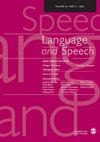节奏是现代希伯来语中的种族标志:来自感知研究和演员民族化形象的证据
IF 1.1
2区 文学
Q3 AUDIOLOGY & SPEECH-LANGUAGE PATHOLOGY
引用次数: 0
摘要
在现代希伯来语中,只有三个音段标记通常被认为是受种族条件制约的,而且这些标记在第二代和第三代使用者中的使用率已明显下降。然而,第一代希伯来语使用者的语言背景各不相同,再加上住房和劳动力中的种族隔离,这种社会语言状况似乎是通过语音进行社会识别的肥沃土壤。我们报告了两项关于现代希伯来语前音变异的研究:一项感知研究和一项 "配对 "语料库研究。第一项研究的结果表明,即使没有已知的分段标记,年轻母语使用者的种族感知仍可能在两种主要种族身份(中东米兹拉希人和欧洲阿什肯纳兹人)之间存在差异。主要的声学相关因素是节奏,以元音在语篇中的持续时间比例来衡量。在第二项研究中,我们发现演员的语音节奏也会受到他们所描述的种族身份的影响,这表明这一变量在社会中是显著的,而且对某些说话者来说是可控的,足以参与风格的转变。越来越多的研究表明,相对温和的节奏变化有助于社会认同,而在本研究中,节奏变化也有助于种族形象的塑造。本文章由计算机程序翻译,如有差异,请以英文原文为准。
Rhythm Is a Marker of Ethnicity in Modern Hebrew: Evidence from a Perception Study and Actors’ Ethnicized Portrayals
In Modern Hebrew, only three segmental markers are typically acknowledged as ethnically conditioned, and usage of these markers has significantly decreased in second and third generation speakers. Yet the sociolinguistic situation of diverging language backgrounds of first generation speakers, compounded with ethnic segregation in housing and the workforce, seems like a fertile ground for social identification from speech. We report two studies on prosodic variation in Modern Hebrew: a perception study and a “matched-pairs” corpus study. The results of the first illustrate that even in the absence of the known segmental markers, ethnicity perception of young native speakers may still diverge between two major ethnic identities, Mizrahi (Middle Eastern) and Ashkenazi (European). The main acoustic correlate was rhythm, measured as the proportional duration of vowels in the utterance. In the second study, actors’ speech rhythm was found to be modulated by their portrayed ethnic identity in the same direction, suggesting that this variable is socially salient—and for some speakers, controllable—enough to be involved in style shifting. This study joins a growing body of work illustrating that relatively mild rhythmic variation can contribute to social identification, and in the current case, also for ethnicity portrayal.
求助全文
通过发布文献求助,成功后即可免费获取论文全文。
去求助
来源期刊

Language and Speech
AUDIOLOGY & SPEECH-LANGUAGE PATHOLOGY-
CiteScore
4.00
自引率
5.60%
发文量
39
审稿时长
>12 weeks
期刊介绍:
Language and Speech is a peer-reviewed journal which provides an international forum for communication among researchers in the disciplines that contribute to our understanding of the production, perception, processing, learning, use, and disorders of speech and language. The journal accepts reports of original research in all these areas.
 求助内容:
求助内容: 应助结果提醒方式:
应助结果提醒方式:


